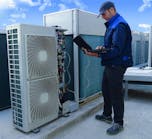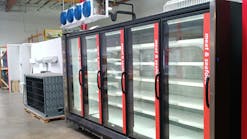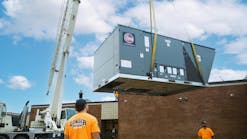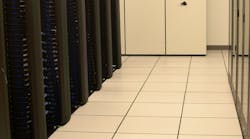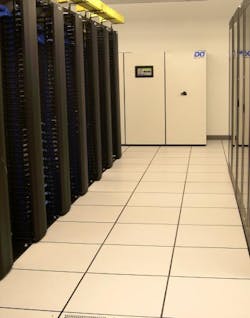The modern data center presents unique challenges to the service technician. The data centers, with all of the electrical equipment (servers, UPS, and storage units) produce high sensible heat load. To remove the high sensible heat load from the space there are specialty air conditioner units. These Computer Room Air Conditioner (CRAC) units are designed differently than comfort air conditioning. The biggest difference is the sensible heat ratio. For comfort air conditioning the heat ratio typically is 60% to 70%, that is, the coil/air flow design is to remove 30% to 40% latent heat load (moisture) and 60% to 70 % sensible heat load. The CRAC unit design is for 85% to 95% sensible heat load and 15% to 5% latent load. These units will remove the high sensible heat load produced by the electronic equipment in a data center.
The intent of the CRAC in the data center is to control the room temperature, humidity and continuously clean the air. This control is accomplished with the use of a microprocessor controller. The microprocessor will monitor the room conditions, control the temperature, control the humidity, alarm if there are any failures and, if connected to a building management system (BMS), letting the building owner know in real time the condition of the data center.
Most CRAC manufactures have their own logic for the controllers. With each manufacturer's logic being different from the others, you will need to read the IOM for their microprocessor functionality. There is some commonality in the way they control the space that we will review. For cooling mode, the temperature of the controlled space rises above the set point of the room plus the dead band (most controllers have adjustable dead bands), and will activate the cooling mode. As the space temperature decreases, the cooling mode will deactivate at the temperature set point.
The humidifier is activated when the relative humidity in the space drops to the humidity set point minus the dead band. The humidifier is deactivated as the relative humidity increases to the set point.
The dehumidification mode process in most cases is based on relative humidity. In this case, the cooling mode is activated when the humidity rises to the set point plus the dead band. The cooling mode will be active until the set point for the humidity is reached.
How is the Controlled Space Designed
Data center design is a specialized field in the engineering of the modern building. In this article, it is not the intent to cover all of the aspects of data center design. It will cover the highlights and point out items in the room design and/or construction that can help you diagnose control problems in a data center.
The data center itself will or should be a separate entity within a building. The space needs to be isolated from the rest of the building, with its own utility service, no connections with the building HVAC system, and with its own fire suppression system.
In isolating the space from the rest of the building, the space needs to have a vapor seal surrounding the entire envelope. The vapor seal needs to prevent the migration of moisture in and out of the controlled space. Without a tight vapor seal, the CRAC units will not be able to control both the temperature and humidity on year round bases.
Construction Features
Sealing of the data center is more than just drywall and paint. A properly constructed room will consist of 6 mm polyurethane sheeting behind the drywall and covering the ceiling of the room. All wall penetrations will be sealed with vapor-proof caulking; this generally is fireproof caulking to meet code. All conduit pipes that enter the controlled space will be sealed after the wiring/communication cables are in place. This is done by sealing inside of the conduit to prevent air and moisture infiltration.
There are vinyl ceiling tile and grids that are designed for use in data centers that will stop migration of moisture. When these tiles are teamed with vapor proof fluorescent lights that need to be used to stop migration.
Most data centers have bare concrete floors. Concrete is very porous when it comes to moisture migration. The concrete needs sealing with a vapor proof sealant to stop the migration of moisture.
Humidity and temperature control in a data center is critical to the longevity of the servers and other IT equipment. The ASHRAE technical committee (TC 9.9) has recommendations and guildlines for data center design and standard operating conditions. For more detailed information regarding data center design, consult the ASHRAE TC 9.9 manuals.
Data Center Humidity Control From a Service Standpoint
Maintenance of HVACR equipment is necessary for all operations, but it is critical for a data center. Their units operate 24 hours a day, seven days a week. If the CRAC was an automobile it would travel over 435,000 miles a year. Regular maintenance is required for for all CRAC units. The manufacturers generally specified monthly and quarterly inspections are required. We will cover only the basic maintenance requirements refer to the manufacture’s IOM for specific information for the unit you are servicing.
If a room is not designed properly or if the vapor seal in the space has been compromised, the humidity levels will be difficult or impossible to control. In many cases if the humidity level is controlled the temperature will be lower than desired and may have undesirable temperature swings.
The humidity control logic is similar for most manufacturers of CRAC units. On a call for dehumidification, the cooling mode is activated. As the room temperature decreases the unit will active the reheat. This reheat will temper the air leaving the cooling coil, allow the air to absorb more moisture. Reheat in general is a supplement to the existing heat load in the room. The reheat is not intended to overcome the cooling capacity of the CRAC unit. If there is a large difference in the heat load in the controlled space and the cooling capacity of the CRAC’s the space will be over cooled.
The extra energy that is used to remove the humidity from the room will affect your customers bottom line. The units will require more maintenance, adds to the cost of ownership of the data center.
Conclusion
In some cases, where the data center is not controllable due to poor design or construction, sometimes it is best not to control the humidity in these spaces at all. By controlling the temperature only of the room, based on the heat load of the equipment, you may find the humidity levels will stabilize within a few percentage points of the desired humidity levels. In these cases the customer will need to educated as to why the room is not at the desired humidity levels and why a few point off of the desired levels makes more sense that fighting for the few humidity percentage points that cannot be achieved.
Steve Wellander is service manager for Data Aire, Orange, CA. Data Aire specializes in protecting data processing centers from overheated and humid environments. For product information, contact John Martin, at [email protected]
This article is based on a presentation Steve Wellander gave during the Refrigeration Service Engineers Society annual conference in October 2013.
